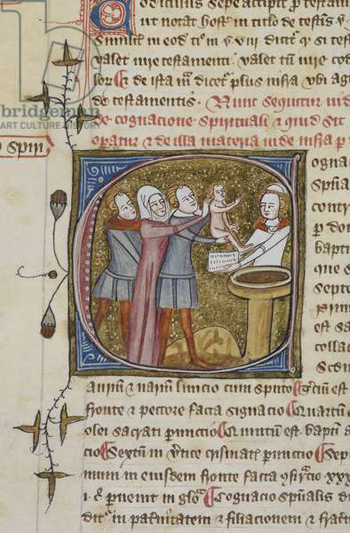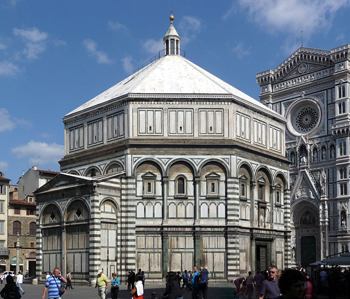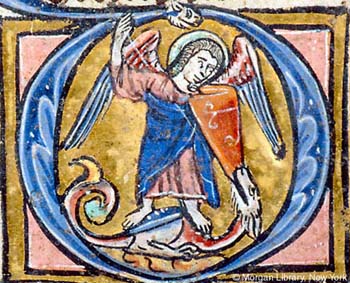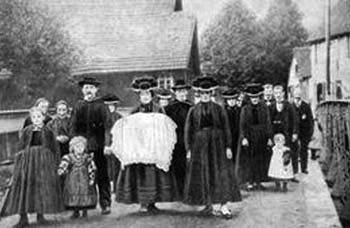About the Church
 |
 |
 |
 |
 |
 |
 |
The Sacrament of Baptism - IV
Sponsors, Place & First Exorcism
The most common case of administering the Sacrament of Baptism is the Baptism of children, so I will mainly address this topic here.
What many people do not realize is that the child must be given a Christian name. If the parents have not chosen one, the priest should add one, which is to be noted in the record.
Sponsors
 The child must have at least a godfather, but normally each child has a godfather and a godmother, who must be Catholics and in good standing in the Church. (1) They are customarily invited to this honor by the parents or guardians of the child. In the absence of any guardian, the priest should choose or designate the godparents.
The child must have at least a godfather, but normally each child has a godfather and a godmother, who must be Catholics and in good standing in the Church. (1) They are customarily invited to this honor by the parents or guardians of the child. In the absence of any guardian, the priest should choose or designate the godparents.
At the time of the Baptism they should physically touch the child at the baptismal fountain.
According to the law of the Church, the sponsor must be at least 14 years of age and know the basic dogmas of our Holy Faith. The godmother may hold the child in her right arm during the ceremony and the godfather may answer for him, always touching him – usually putting his hand on the child's shoulder. At the principle moment of the Baptism he also holds the lit candle. It is the duty of godparents to ensure the spiritual welfare of the child, especially in the absence of parents.
Place of Baptism
The ceremony of Baptism should be administrated in three different places:
The first requirement is the establishment of the name: It is important to give a Christian name to the one who will be made a Christian.
Next, comes the instruction of the Faith: The ceremony begins at the door of the Church at the narthex with two questions addressed to the child that must be answered by the sponsor. They are:
The word exhalation comes from ex-halatio in Latin, which means to blow air out of one’s mouth. In the ceremony of Baptism it represents the breath of the Holy Spirit that comes over the child as the priest blows air on the child’s face who is being baptized.
 The priest performs the exhalation and the first exorcism followed by the first impression of the cross: The ceremony of exhalation consists of blowing three times on the child’s face, thus beginning the series of exorcisms that will be performed in the Baptism. Those exorcisms have as objectives:
The priest performs the exhalation and the first exorcism followed by the first impression of the cross: The ceremony of exhalation consists of blowing three times on the child’s face, thus beginning the series of exorcisms that will be performed in the Baptism. Those exorcisms have as objectives:
The Catechism of the Council of Trent says: "The priest blows three times on the face of the one who is going to be initiated in order to repel the power of the old serpent and restore the breathing of the life he had lost." (3)
Now, the way of proceeding – says the Enchiridion Liturgicum - is "not in the form of a cross, nor in a breath mode, whereby the expelled air is warm, but with pursed lips, which makes cold air a sign of defiance and expulsion. (4) On this there is another opinion but it is not convenient to dispute about it [non ergo pertinet contra istum disputare]." (5)
 The exhalation is done on the face of the catechumen because this is the main (most noble) part of the body and because it is like the door to the soul. It is repeated three times to show the insistence of the expulsion and in honor of the Holy Trinity.
The exhalation is done on the face of the catechumen because this is the main (most noble) part of the body and because it is like the door to the soul. It is repeated three times to show the insistence of the expulsion and in honor of the Holy Trinity.
Since ancient times, the Church was convinced of what John the Deacon wrote:
“There is no doubt that before someone is reborn in Christ, he is strictly under the power of the Devil … to exhale on him is, therefore, to exorcize him so that the Devil flees and Christ Our Lord enters instead.” [Non est dubium, quod prius quam aliquis renascatur, in Christo diabolicae potestati teneatur ad strictus… exufflatus igitur exorcizatur, ut fugato diabolo, Christo Deo nostro paretur introitus] (6)
John was a deacon in the Church of Rome during the pontificate of Pope Symmachus (498–514). He is known only from an epistle he wrote to a Senarius, an illustrious man (vir illustris) who had asked him to explain aspects of the Christian initiation into the Church. His name, simply 'John the Deacon,' appears in the works of many early ecclesiastical writers.
John the Deacon's response provides a good description of the catechumenal process and initiation rites being used in Rome at the beginning of the 6th century. He covers pre-baptismal exorcisms; the ritual use of salt; the anointing of the ears, nostrils and breast of the candidate; the use of milk and honey for the first Communion; the ritual of immersion; the special white clothing for the newly baptized; and the need for even infants to undergo the process, saying that: “Their salvation should come through the profession of another, since their damnation came by another's fault.”
 His authority relies on the fact that he is simply describing what the Church believes and practices according to the example of Our Lord Jesus Christ.
His authority relies on the fact that he is simply describing what the Church believes and practices according to the example of Our Lord Jesus Christ.
After the exhalation the child is marked with the sign of the cross.
This is followed by the first imposition of the hands.
Next comes the exorcism of the salt and its imposition on the tongue of the child.
These parts constitute the ceremonies of the remote preparation for Baptism.
In the next article I will address the near preparation for it.
To be continued

What many people do not realize is that the child must be given a Christian name. If the parents have not chosen one, the priest should add one, which is to be noted in the record.
Sponsors

Godparents presenting an infant to a priest in a Baptism scene representing spiritual kinship (Cognacio spiritualis)
At the time of the Baptism they should physically touch the child at the baptismal fountain.
According to the law of the Church, the sponsor must be at least 14 years of age and know the basic dogmas of our Holy Faith. The godmother may hold the child in her right arm during the ceremony and the godfather may answer for him, always touching him – usually putting his hand on the child's shoulder. At the principle moment of the Baptism he also holds the lit candle. It is the duty of godparents to ensure the spiritual welfare of the child, especially in the absence of parents.
Place of Baptism
The ceremony of Baptism should be administrated in three different places:
- The narthex, which is the porch of the Church;
- The nave; and
- The baptistery: The baptistery should be either a separate chapel or at least a separate area with a railing around it. If there are not different visible distinctions among these three places, the priest and godparents should move nearer to the baptismal font.
The first requirement is the establishment of the name: It is important to give a Christian name to the one who will be made a Christian.
Next, comes the instruction of the Faith: The ceremony begins at the door of the Church at the narthex with two questions addressed to the child that must be answered by the sponsor. They are:
- The priest asks the child by his name: “NN ... what does thou ask of the Church of God?” The answer is: “Faith.”
- “What does faith bestow on thee?” The answer is: “Life everlasting.” Then follows a statement made by the priest.
The word exhalation comes from ex-halatio in Latin, which means to blow air out of one’s mouth. In the ceremony of Baptism it represents the breath of the Holy Spirit that comes over the child as the priest blows air on the child’s face who is being baptized.

The ancient Florence Baptistery with its famous East Doors of Paradise dates to the 4th century
- To expel the Devil who, not satisfied with possessing the soul of the catechumen through original sin – and through mortal sin if there is any – also wishes to possess the body through possession or obsession;
- To inspire feelings of penance in the catechumen in order to remind him that his soul is in the power of Satan and alert him that, after being released, he should strive never to sin. The exhalation is one of the oldest parts of the ceremony of Baptism, so much so that St. Augustine himself mentions it in his debate against the Pelagians.
The Catechism of the Council of Trent says: "The priest blows three times on the face of the one who is going to be initiated in order to repel the power of the old serpent and restore the breathing of the life he had lost." (3)
Now, the way of proceeding – says the Enchiridion Liturgicum - is "not in the form of a cross, nor in a breath mode, whereby the expelled air is warm, but with pursed lips, which makes cold air a sign of defiance and expulsion. (4) On this there is another opinion but it is not convenient to dispute about it [non ergo pertinet contra istum disputare]." (5)

The exorcism that expels Satan from the soul is an important element in the baptism
Since ancient times, the Church was convinced of what John the Deacon wrote:
“There is no doubt that before someone is reborn in Christ, he is strictly under the power of the Devil … to exhale on him is, therefore, to exorcize him so that the Devil flees and Christ Our Lord enters instead.” [Non est dubium, quod prius quam aliquis renascatur, in Christo diabolicae potestati teneatur ad strictus… exufflatus igitur exorcizatur, ut fugato diabolo, Christo Deo nostro paretur introitus] (6)
John was a deacon in the Church of Rome during the pontificate of Pope Symmachus (498–514). He is known only from an epistle he wrote to a Senarius, an illustrious man (vir illustris) who had asked him to explain aspects of the Christian initiation into the Church. His name, simply 'John the Deacon,' appears in the works of many early ecclesiastical writers.
John the Deacon's response provides a good description of the catechumenal process and initiation rites being used in Rome at the beginning of the 6th century. He covers pre-baptismal exorcisms; the ritual use of salt; the anointing of the ears, nostrils and breast of the candidate; the use of milk and honey for the first Communion; the ritual of immersion; the special white clothing for the newly baptized; and the need for even infants to undergo the process, saying that: “Their salvation should come through the profession of another, since their damnation came by another's fault.”

A baptism procession in Black Forest, Germany in 1922, demonstrates the importance given to the Sacrament
After the exhalation the child is marked with the sign of the cross.
This is followed by the first imposition of the hands.
Next comes the exorcism of the salt and its imposition on the tongue of the child.
These parts constitute the ceremonies of the remote preparation for Baptism.
In the next article I will address the near preparation for it.
To be continued
- 1917 Codex Iuris Canonici, 765 §2, 766 §2
- Théophile Bernard, Cours de liturgie romaine, ou, Explication historique, littérale et mystique, 232
- Catechism of the Council of Trent, Part II on the sacrament of Baptism, c. II, n. 65.
- Polycarpus Radó, Enchiridion Liturgicum (Roma: Herder, 1961), p. 689.
- In this regard, says Baruffaldi: “with open lips/mouth and not closed” [ore lato e non stricto] in order not to bother the child. Ibid.
- Epistle of the year 492, Ad Senarium n. 3, in Patrologia Latina, vol. 59, 401-402.

Posted October 8, 2018















